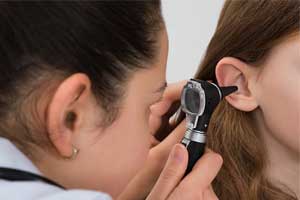- Home
- Editorial
- News
- Practice Guidelines
- Anesthesiology Guidelines
- Cancer Guidelines
- Cardiac Sciences Guidelines
- Critical Care Guidelines
- Dentistry Guidelines
- Dermatology Guidelines
- Diabetes and Endo Guidelines
- Diagnostics Guidelines
- ENT Guidelines
- Featured Practice Guidelines
- Gastroenterology Guidelines
- Geriatrics Guidelines
- Medicine Guidelines
- Nephrology Guidelines
- Neurosciences Guidelines
- Obs and Gynae Guidelines
- Ophthalmology Guidelines
- Orthopaedics Guidelines
- Paediatrics Guidelines
- Psychiatry Guidelines
- Pulmonology Guidelines
- Radiology Guidelines
- Surgery Guidelines
- Urology Guidelines
Fluoroquinolone ear drops may increase risk of eardrum perforation

Fluoroquinolone ear drops may increase the risk of eardrum perforation, finds a new study.
The researchers conducted a cohort study to examine whether the use of quinolone ear drops increased the risk of perforation with intact tympanic membranes and acute otitis externa (AOE).
The researchers used Medicaid clinical encounter and pharmacy billing records from 1999 through 2010 and analyzed treatment outcomes in 94,333 patients treated for Acute Otitis Externa. risk of TMP.
Of the patients included in the study, 43,653 were treated with quinolone ear drops with or without corticosteroids and 50,680 were treated with neomycin-plus-hydrocortisone ear drops. Overall, 38 cases of TMP were diagnosed in patients exposed to quinolone ear drops during follow-up, compared with 25 in neomycin-exposed patients. When adjusted for demographics and other covariates, the risk of TMP associated with quinolone ear drops was more than twice that of neomycin ear drops (adjusted hazard ratio [HR], 2.26; 95% confidence interval [CI], 1.34 to 3.83).
When comparing individual quinolone preparations against neomycin, the adjusted HRs were 2.53 for ofloxacin (95% CI, 1.27 to 5.05), 2.24 for ciprofloxacin plus hydrocortisone (95% CI, 1.03 to 4.85), and 2.30 for ciprofloxacin plus dexamethasone (95% CI, 1.09 to 4.87). Sensitivity analyses were consistent with the primary analysis.
The authors concluded that the use of quinolone ear drops to treat AOE is associated with a previously unreported increased risk of developing TMPs. Selection of otic preparations to treat self-limited conditions with intact tympanic membranes should consider TMP risk.
They further added that the risks and benefits of otic quinolones should be considered prior to treatment of AOE. "Therapy duration, volume dispensed, and refills should be limited to what is necessary to ensure clinical cure. Patients should be counselled on the risk of TMP and monitored for TMPs in follow-up visits."
For more details click on the link: https://doi.org/10.1093/cid/ciz345

Disclaimer: This site is primarily intended for healthcare professionals. Any content/information on this website does not replace the advice of medical and/or health professionals and should not be construed as medical/diagnostic advice/endorsement or prescription. Use of this site is subject to our terms of use, privacy policy, advertisement policy. © 2020 Minerva Medical Treatment Pvt Ltd